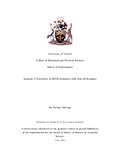| dc.description.abstract | The many uncertainties involved in the payment of losses makes the estimation of the
required reserves more difficult. Yet, some of the existing methods, such as the popular
chain-ladder, are simple to apply. However, it has become evident that there is a need
for better ways not only to estimate the reserves, but also to obtain some measures
of their variability. The chain-ladder is used as a benchmark in this study due to its
generalized use and ease of application. Although this facilitates comparisons between
differentmethods,studieshaveshownthatdifferentclassesofinsurancepresentdifferent
development patterns hence the need to apply a variety of methods.
This dissertation aims at presenting different loss reserving models both deterministic
and stochastic and compare the variability in the models. The objective will be to
develop and implement a loss reserving model that combines both deterministic and
stochastic methods to estimate reserve provisions for different classes in general insurance.
In this study we also present Bayesian method to model both claim frequencies
and severity using some well defined assumptions and to use the resulting predictive
distributions to estimate loss reserves, allowing for negative values. In this study we
assume that the expected loss payments depends upon unknown parameters that determine
the expected loss ratio for each accident year and the expected payment lag.
The distribution of outcomes is given by a collective risk model in which the expected
claim severity increases with the settlement lag. The claim count distribution is given
by a Poisson distribution with its mean determined by dividing the expected loss by
the expected claim severity. The parameter that describe the posterior distribution are
calculated using a Monte Carlo simulation algorithm. Models back testing with real life
data have shown that in some classes of insurance the actual and expected estimates vary significantly there by discrediting the models and hence the need to compare different
models and study the variability presented. | en_US |

